History
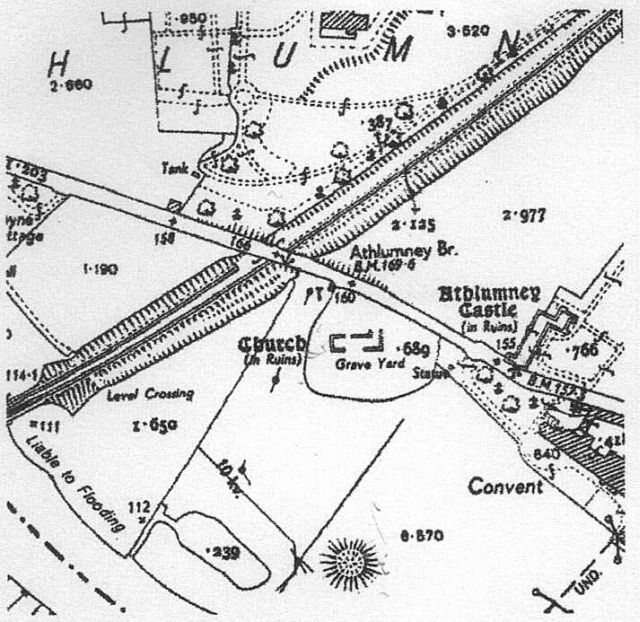
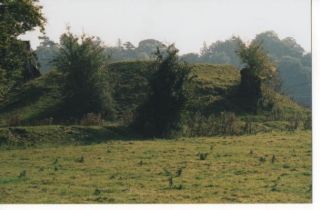
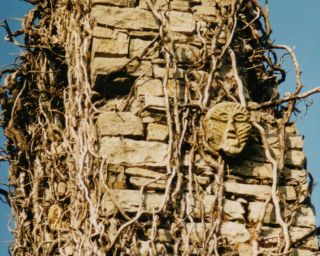
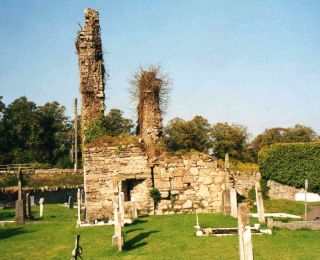
Athlumney Church (above). Today all that is left of it are the outlines of the nave, the double bell cote, the room for the priest at the left of the altar, and the strange pagan "charm" visible on its tower. (above right) (Photos © N&DHS)
There is an interesting 15th century tombstone of a knight in the nave of the church-the Cheever Goff Stone.
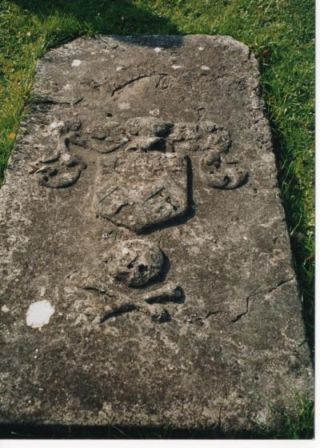
“Cheevers-Goff " (right)
where the De Profundis is recited and then the coffin is carried around the graveyard before burial.
Dean Cogan recorded an eight sided Baptismal Font in 1865 but this has disappeared.
The Table Tomb left of the entrance belongs to Peter Metge of the Navan Huguenot family who became Lord Chancellor of Ireland in the 18th century.
In 1756 when the first bridge was built over the Boyne connecting Navan to Athlumney, the graveyard became the graveyard of the town until the new cemetery was built at the turn of the 1900s.
In the 1400s the Lord of Athlumney decided to build a Castle in Athlumney.
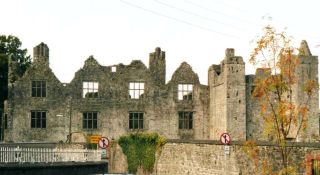
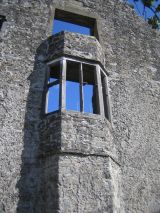 e of Athlumney.
e of Athlumney.The last lord of Athlumney was Sir Launcelot Dowdall. The Dowdalls, lost their land during the Cromwellian Plantation and got it back under Charles II. In the 1660s, they backed James 11 in the war against William of Orange. According to tradition he set fire to his castle rather than see it occupied by William of Orange after his victory at the Battle of the Boyne in 1690. He crossed the Boyne and sat on the opposite bank to watch his castle "blazing and flickering in the calm summer night". He left for exile in France while the ashes were still hot, never to return.
Athlumney Motte:
A Description and Analysis by Noel E French 2005
It is difficult to accurately date the construction of the Motte at Athlumney but using documentary evidence, topography, and archaeological evidence from other sites it is estimated that the Motte was constructed between 1173 and 1200.
The barony of Skreen was granted to Adam de Feipo before 1176. Mottes were erected within a decade of settlement and were caputs for the baronies. Hugh de Lacy erected a motte for de Feipo but the location of this motte is not known.
Secondary mottes such as Athlumney were erected as centres for manors. In a charter confirmation dating to before 1194 Amaury de Feipo The Big, is listed as Lord of Athlumney, holding his lands in fee from Adam de Feipo. Secondary mottes were located at sites that could be defended such as the one at Athlumney. Control of the river and crossing points was a priority for the Anglo Normans in order to establish security for the new settlers. A motte such as Athlumney would date to the earliest period of colonisation.
Mottes were not built after the thirteenth century. In fact the motte was already going out of fashion in England and Europe when the first mottes were being erected in Ireland. Athlumney motte would fit into this pattern.
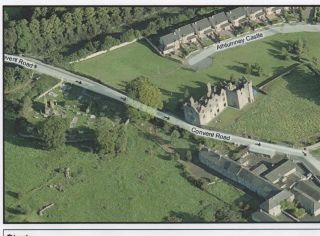
********
Athlumney - a Short History
The motte at Athlumney was constructed in the years after 1172 when Hugh deLacy, Lord of the Liberty of Trim, the Old Kingdom of Meath, had handed the Barony of Skreen to Adam de Phiepo. de Phiepo had parcelled his barony into demesnes, and one of these demesne was the Demesne of Athlumney. We don't know who got Athlumney but we know that he was a knight, perhaps related to de Phiepo. He built the motte, a wooden tower on the top, a bailey at the bottom, enclosed with a fence where he lived with his family, retainers, cattle and horses.
In the 1200's descendents of de Phiepo built the stone church at Athlumney where the cemetery is today. It was built in the same style as many contemporary churches - Donaghmore and Ardmulchan. It is a rectangular building with a double or triple bell cote at the end, with room for the priest to live in. The right to the tithes on clerical income from Athlumney Demesne as from other parishes in the Skreen Barony was given by de Phiepo to the Cistercian Monastery of St. Mary in Dublin, which a brother of de Phiepo has entered. The monastery appointed a vicar to look after Athlumney and he had a small salary for doing so.
In the 1600's the Lord of Athlumney decided to build a castle in Athlumney. It was built for defence and not for comfort; look at the thick walls, dark corridors, slitted windows to make entry of arms impossible for all but the most skilful archers. It has a secret room, still surviving, which is entered from the second floor, down a stairs in the wall.
In more peaceful times, the Lords of Athlumney, the Dowdalls, built a manor house. It had large corridors and its ground floor kitchen provided heat for the first floor rooms where the Lord lived. The tiny rooms in the attic for servants all speak of comfort as the shaping principle of the building was modelled on the then fashionable Tudor architecture. The finest example and first of this style was the palace of Hampton near London given by Cardinal Wolsey as an unsuccessful bribe to his sovereign, Henry V111.
The Dowdalls, who lost their land during the Cromwellian Plantation and got it back under Charles 11, in the 1660s, backed James 11 in the war against William of Orange. Dowdall knew that this loss would be final and before leaving Athlumney he burned it down and went into exile.
The Coddingtons of Oldbridge were later owners. A daughter of the Coddingtons ran away to the American Colonies with an impecunious soldier, John Fenner. He became an official in the government of the state of Virginia. He was the original Fenner of the financial corpoation of todays Merrill Lynch, Pierce, Fenner and Smith.
The Somervilles were later owners. Thomas Somerville, Member of Parliament for Drogheda was a Home Secretary in the the British Government. The Sommerville family took on the title Lord Athlumney. The Somerville mansion survives at Kentstown.
When the estate was broken up, the land around Athlumney castle was bought by Bishop Nulty for the Sisters of Mercy. He planned to build a seminary in Athlumney to replace the seminary in Academy Street. This never happened because when Bishop Nulty died, his successor transfered the seminary to Mullingar.
********
Athlumney Ruined Church and Graveyard
Beryl F. E. Moore
In one of John O'Donoovan's letters we read:
Athlumney Parish is called Ard Luimneach by the local Irish speakers. In the townland of Athlumney is an old church in ruins called Teampal Athlumney. The patron day of the parish is St. James Day on 27 July.
*******
A Journey to Lough Derg
by Isaac Butler
Isaac Butler made his journey to Athlumney about 1740 and recorded this inscription but not a single word of it can be seen now.
"Coming to Athlumney there are ruins of a large church with remains of several tombs and gravestones, on one may be read Ye Inscription
Hoc Monumentum est erectum inveri
Bonae vite Boni Guiliemi
Gough Memoriam
Et ejus Sponsae Matronae
Spectasoimae
Anno Chevers Quae Hic
Tumulature et Utri
Useque Posteris Anno
Sub Mole Viator
Conditur et Coelum Sciandere
Pace Deum"
********
Wilde's, Boyne and Blackwater
Immediately approaching Navan, the river makes a bold sweep around the foot of the hill from which rise the ruins of Athlumney Castle. In the immediate vicinity is the ruin of a small church of about the 14th century with a triple belfry in the west gable. Of the history of this church little is known with certainty. Sir Launcelot Dowdall forfeited his property in 1700 when many a gallant Irish soldier or noble Irish gentleman forfeited his broad lands. The people of Navan have turned their backs on the broad Boyne and Blackwater, scarcely a glimpse of which can be obtained from any of its narrow streets.
*******
Shell Guide to Ireland, by Lord Killanin and Michael Duignan
Athlumney Church is a small 14th century one with a triple belfry.
*******
Athlumney Church
The patron day is St. James Day, 27th July. Parishes under this dedication very often have connections with pagan rites, for this saint's day was so close to the pagan festival of Lughnasa on 1st August, that the early Christian fathers used it as a counter attraction. This is a 13th century church measuring 63 feet by 19 feet.
The castle is comprised of an early Norman tower, a 15th century residential castle and a 17th century residential addition, so this church must have been built and used by the people who built and used the tower.
There is a triple belfry tower. Its three bells served as follows:
1. To summon the parishioners to worship.
2. The Monstrance Bell: to warn the congregation of the elevation of the Host. In olden times churches were small, and men and boys rarely got inside but knelt outside in the graveyard. It was necessary for them to know when such an important part of the service was about to begin.
3. A bell to be rung in emergencies. An example would be Norsemen rowing up the river Boyne. [in earlier times]
Triple belfries are generally found in churches nearer the bigger rivers on the east coast of Ireland.
There were north and south doorways, and apparently a sacristy to the left of the altar. The stonework is very rough and primitive with very little mortar. For a long time it has been covered with a huge crop of ivy and this pest uses the lime of the mortar leaving only the sand, causing walls to fall down.
A Norman tower stood at the west end and when no longer needed the church expanded into it leaving half of the tower's lower storey as a room, likely for the use of the priest. This tower had a large slit window on each side on the ground floor. All trace of the east window is gone.
Dean Cogan in his history of the Diocese of Meath says: "There was a font here in his day (1865) which was 8 sided, unornamented, the circular bowl measured 25 inches in diameter and had an 8 inch hole. It had a pedestal 20 inches in diameter."
Beryl Moore failed to find the vessel or learn of its whereabouts.
Several authorities (Beryl Moore does not give the names) refer to carved heads built into the walls of this church. One was thought to represent a Carmelite monk with the cheeks scored to suggest hair, also one or two grotesque heads referred to as devilish animals.
A 1910 writer in the Royal Society of Antiquaries of Ireland says: "Coffins are carried round Athlumney Church (not round the graveyard) and then rested on the Chevers Goff Slab for a prayer and then carried to the grave."
Why are coffins in some old churchyards carried around the graveyard? The answer "This is the poor fellow's last journey and it would be unkind to bring him the shortest way to his grave" is too trite to be true. Beryl Moore thinks it is a memory of the first cleric, often the patron saint of the parish walking round the piece of land given by the local chieftain for a church and graveyard, and blessing it, walking in the footsteps of the saint.
Why are coffins placed on certain tombstones for a prayer? Likely there was a person buried in that grave who had died unscriven and so was according to old ideas unable to be interred with full Christian rites. The De Profundis or Pater Noster said over him every time a coffin comes into the cemetery would be thought as helping the poor fellow.
Royal Society of Antiquaries of Ireland, Volume 25, page 161 says this church belonged to St. Marys Abbey, Dublin and after the Reformation to the family of Chief Baron Deane.
********
Memorials of the Dead, Vol. 8, page 137, Tombstones in Athlumney
1. 1709 the oldest recorded slab in the graveyard. It is broken in pieces and sunk in the ground in the east end of the church ruins. The inscription runs "This tombstone was erected by Nicholas Murray of the Long Causeway (here spelt Caseway) and of Ye Family of Castlemurray in Roscommon in the year 1708 for interring himself and his posterity. Here Lieth the body of Mary Murray, Alias Everard his wife of Ye Family of Randalstowne who died Ye 18th Day of March 1709 aged 73 years. Requiescat in Pace."
2. 1763 at the south side of the graveyard is a flat slab to Mary Percival alias Pomfrey born in Lanark City, Scotland.
3. 1769 in the eastern portion of the cemetery close beside the railed in grave of Rev. James Joseph Gaynon DD is a headstone erected to the memory of Father Hennery Magrath priest of Ye parish who died on 22nd August 1769 aged 48. The position of this headstone is so close to the railing that it makes it very awkward to read. Being a priest he is buried facing west, that is, towards his congregation. The laity are buried facing east, that is, facing their Redeemer.
4. 1784 and 1786. On the north side of the east end of the church inside the ruin is a large slab standing on carved pedestals about a foot high. It is to the family of Lee. Above the inscription is a fine carving of angels heads, sunrays and IHS.
5. 1800: A tabletomb to James McCormick of Simonstown who departed this life 17th November 1800 aged 63. Also the body of the Rev. Edward McCormick aged 45 years.
6. The Metge Tomb - North east of the church and below the entrance gate. This man was one of the commissioners for the making of the canal from Drogheda to Trim. The law empowering them to carry out the work was passed in 1787 but it was only completed as far as Navan. Baron Metge was judge of the Court of Exchequer.
The inscription runs:
Hoc Monumentum Elatum
30 Maii Ann. Dom. 1803
Petro Metge
De Athlumney Comitatu Medensi
Nuper
Barono Scaccario Hibernici
Pro Propinquis Et Relativis
Eximie Charis
Signuk Maximae Affectionis.
7. 1826. The grave of the Rev James Joseph Gaynon DD: Cogan says that this cleric was born in Frankfort, King’s County (Offaly). He studied in Rome, and read a distinguished course. In 1822 he took the oath of Propaganda, and is registered “792” in that catalogue. He was ordained in 1824 and returning to Ireland was appointed to the Curacy of Navan. He was a man of surpassing eloquence and of great zeal. He died on 31 August 1826 profoundly lamented by the people, and his remains were accompanied to the churchyard of Athlumney by one of the largest funerals ever known in County Meath. The people of Navan erected this monument, with this inscription:
This Monument was erected by the parishioners of Navan,
In memory of the Very Rev. James Joseph Gaynon D D
Graduate of Propaganda, Missionary Apostolic, Prelate of
Monteletta, and late assistant to the Right Rev. Dr. Plunkett Roman Catholic Bishop of Meath. The short term of two years completed the ministry of this young Divine, which he supported with remarkable dignity and grace.
By his powerful eloquence and pathetic appeals he gained many a soul for Christ. His entire time was occupied in discharging the sacred duties of his calling, and in administering the bread of life to the hungry. He lived in the hearts of his parishioners and died universally lamented, the 31 of August, in the year of our Lord 1826, and in the 26th year of his age. Requiscat in pace. Amen.
Bishop Patrick Plunkett who occupied the Episcopal Throne of Meath from 1778 to 1827 was born in Kells, County Meath on Christmas Eve 1738 and related on his mother’s side to the Murphy family of Braymount in the Parish of Summerhill. He was educated in Paris in the famous College of Trent Trois. He went to the Continent on his 14th birthday. He was ordained in 1764 took further degrees and became one of the four superiors of the Irish College of the Lombards, and in 1778 he was elected Bishop of Meath on the death of Dr. Chevers, and consecrated in Paris.
On his journey to this country his ship was attacked by the American privateer, Paul Jones who robbed him of nearly everything he possessed. Before leaving France he had been presented with a complete episcopal outfit and a first class library. He lived all his life in Navan after becoming Bishop of Meath, although some bigots tried to prevent it. He commenced his first visitation of the diocese in 1780 and during his 46 years he visited and preached annually in each parish in his large see. He rode a horse from Chapel to Chapel and kept a diary. Unfortunately several years are missing- 1781, 1783 and 1784. He sleeps in the Chapel of Navan without a slab or carved stone over him.
Bishop Plunkett was 89 years of age when he died and some years before that he asked Rome to appoint a certain priest as his assistant, but Rome appointed another man not persona grata with the old bishop. There was bitterness for several months and then young Rev. Gaynon was sent by Rome and he was a complete success.
The Chevers Slab (see photo above)
A large unlettered slab lies inside the church about one third of the way from the east window and near to the south wall. It is level with the ground and measures 6 feet 9 inches by 3 ½ feet. It bears a coat of arms impaled, above a helmet and diapering, below a skull and crossbones. The Chevers and Goff coats of arms are displayed, all cut in high relief.
Chevers Coat of Arms:
On dexter side, a chevron between 3 goats. Chevre is the French for goat. Passant (walking) placed 2 and 1. Motto is “ God is my trust” which in old French is “ Dieu Ma Fianc”.
On sinister side, chevron between 2 Fleur De Lys in chief, and a Lion Rampant (standing on the hind legs ) in base. This is the wife’s family coat of arms. It must be remembered that the dexter coat is on your left and the sinister coat is on you right, because the shield is pictured as worn in front of the chest as a coat or held in front of it as a shield.
Chevrons may represent:
1. Two rafters of a house. If this is the correct meaning, it is a very early heraldic design adopted when houses with rafters supporting a roof were very rare.
2. Bottom half of a Saltire Cross ( St. Andrews Cross )
3. Sword cuts in the shield which originally was made of leather.
4. Bands across the shield to strengthen it.
*******
The Chevers of Normandy
A very old and distinguished family who lived in Normandy before the middle of the 11th century and were amongst the first to join Duke William’s standard in 1066 to undertake the invasion of England. A hundred years later descendants of these knights went with Strongbow from south west Wales to attempt the conquest of Ireland. This Norman leader was so named because he could bend the largest bow being an exceptionally strong man.
In course of time the Chevers family spread to various parts of Ireland but the oldest branch remained settled in County Wexford at Ballyhaly. One of these, Sir Christopher Chevers of Ballyhaly married as his second wife Lady Anne Plunkett of Macetown Castle in Kilmessan Parish. She was an heiress without brothers, and brought Macetown and vast acres around it to the Chevers. There is a large carved stone, likely the lintel of a fireplace, built into Macetown Castle wall with the coat of arms of this Sir Christopher Chevers and Lady Anne Plunkett on it. We see the Chever’s goats and the Plunkett’s Castle. We know the date of this stone because there are documents existing giving the date upon which Sir Christopher was knighted, 2th March 1556. He died on the 20th March 1581 and is buried in his chapel at Macetown together with his wife Anne Plunkett.
At the confiscation of Cromwell, Sir John Chevers, a direct descendant of Sir Christopher of Macetown Castle, was dispossessed of his castle and estates and transplanted to Connaught.
A direct descendant was Augustine Chevers born in Killynan, County Galway about 1680. He was brought to France in his 14th year and educated in Paris. Later he joined the Augustinians. In 1751 he was consecrated bishop of Ardagh and asked by the old bishop of Meath, Dr. Mac Egan to administer for him the See of Clonmacnoise. Bishop Chevers petitioned the Pope to add this See to Ardagh which was such a small one and this was done. In 1756 Bishop Chevers was consecrated Bishop of Meath and petitioned Rome to remove the See of Clonmacnoise from Ardagh and add it again to the See of Meath. Dean Cogan tells us he had the mortification to receive a copy of his own letter of some years previous stating the reasons why it should have been taken from Meath and added to Ardagh.
Dr. Chevers' first duty on arrival from the continent to take up the administration of the Diocese of Meath was “The Assembly of the 7 Bishops“ in the Castle of Trimbelstown, for the purpose of drawing up a joint pastoral refuting doctrines wrongfully imputed to them. The 7 were: The Archbishop of Armagh, Bishops of Meath, Clogher, Kildare, Derry, Kilmore and Raphoe. They are said to have been clad in frieze, like farmers, to escape discovery.
Dr. Chevers collected £600 to found bursaries in French clerical colleges for Irish students, which were a great help until the French Revolution broke when all were confiscated. While penal conditions continued Dr. Chevers had to hide in secret places during the first part of his episcopacy. Often he had to leave County Meath and retire to his family, but when his niece married an O’Neill of Crackenstown, Ratoath he generally lived with them. In 1758 he became Parish priest of Kilberry and resided at Randelstown in accommodation supplied by the Everards. In his declining years he petitioned Rome for a coadjutor (assistant), naming Rev. Eugene Geoghegan his friend, and this was granted. In 1778 he died at Randalstown, aged 92 years of age and was buried on the south side of the old graveyard of Donaghpatrick. No stone marks the spot.
*******
Athlumney Parish Clergy
Archdeacon Healy: History of the Meath Diocese.
- Cornelius
1620 John Sayler - P. Downes
- Patrick Griffith 1737 Geo. Buchanan
1629 Samuel Clarke 1747 Daniel Beaufort
1641 John Bodkin 1761 Rd. Barry
1677 WM Smith 1788 Geo. Chas Garnett
1684 Thos. Benson 1789 Daniel Augustis Beaufort
1684 Benjamin Colcot 1819 Francis Dancy Hamilton
1715 John Lyan 1831 Robt. Thomson
1715 Dive Downes 1832 Robert Patkrick Dansey Hamilton
1719 Ossary Medlicot 1870 United to St. Mary's Parish Navan
1728 John Grace
*******
Athlumney from John O'Donovan's
Field Name Book of the Ordnance Survey 1835-1836
A townland in the Barony of Skreen bounded by the river Boyne from Athlumney Mills to Kilcarne Bridge.
“Athlumney, The Ford of Luimneach, which means “A bare spot of land” is situated along the River Boyne and contains two thousand four hundred and fifty-three acres, which includes thirty-five and a quarter acres of river. It contains several gentlemen’s residences; Athlumney Castle; Athlumney Church; extensive flour mills; and a flax mill”.In one of John O’Donovan’s letters we read “Athlumney Parish is called Ard Luimneach by local Irish speakers. In the townland of Athlumney is an old church in ruins called Teampal Athlumney. The patron day of the Parish is St. James’ Day i.e 27th July."
*******
Two large mills - one near the confluence of the Rivers Boyne and Blackwater in Navan, one further down the river - were built in the early 1800's by John Blundell, a Lancashire man. Houses for mill workers were built. The mill at the meeting of the Rivers Boyne and Blackwater was later bought by John Spicer and then became Walshe's furniture factory. The outside of the building has been retained in an apartment block. All the furnishings for the Dail Chamber were made here. A large metal water wheel provided the power.
*******
In 1833, a Mrs. Carroll from Trim, distressed at number of little girls begging in Navan gave Father Eugene O'Reilly, Parish Priest of Navan, £500 to help them. Father O'Reilly persuaded the Loreto nuns from Rathfarnham to establish a convent in Navan and land at Athlumney was bought for them.
*******
The canal from Navan to Drogheda met the River Boyne at Athlumney. The canal and the mill water wheel were fed with water by a weir on the River Boyne. The young people of Navan used this area for swimming until the weir was removed by the Boyne drainage scheme in the 1970s.
*******
ATHLUMNEY by Rev G. Rice
“Athlumney, The Ford of Luimneach, which means “A bare spot of land” is situated along the River Boyne and contains two thousand four hundred and fifty-three acres, which includes thirty-five and a quarter acres of river. It contains several gentlemen’s residences; Athlumney Castle; Athlumney Church; extensive flour mills; and a flax mill”. [Ordnance Survey Name Book 1835–1836].
A lot has changed since then but Athlumney still maintains a rural beauty and olde world charm. Places of historic interest mentioned in the survey still survive and bear testimony to an interesting history. In one of John O’Donavan’s letters we read “Athlumney Parish is called Ard Luimneach by local Irish speakers. In the townland of Athlumney is an old church in ruins called Teampal Athlumney. The patron day of the Parish is St. James’ Day i.e 27th July."